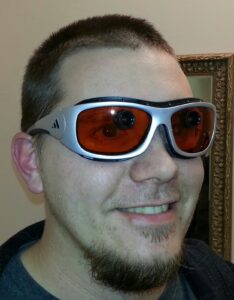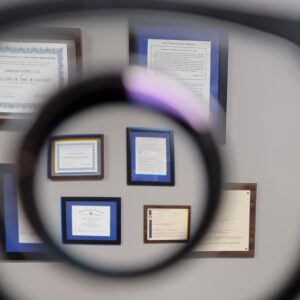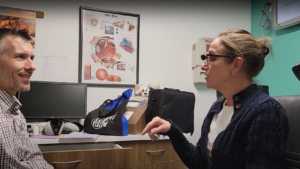Dr. Long’s latest addition to the Midwest Low Vision YouTube playlist, “What is Macular Degeneration?”
Dr. Long’s latest addition to the Midwest Low Vision YouTube playlist, “What is Macular Degeneration?”
While choroideremia is rare, affecting only 1 in 50,000 to 100,000, I’ve seen several patients with this condition for low vision care over the years and they can be helped. Let’s divide the newsletter into two parts: a current overview of the disease…and typical low vision treatment plans.

Choroideremia (CHM) Overview:
CHM mostly affects males due to its X-linked inheritance pattern, but female carriers can have mild symptoms. Symptoms are similar to retinitis pigmentosa and typically start with night blindness during childhood, leading to peripheral visual field loss and eventually total blindness later in life. Currently, there are no approved treatments for CHM, but several therapeutic strategies are under investigation.
Gene replacement therapy using adeno-associated virus (AAV) vectors is one of the most advanced, and promising, treatment strategies. Other emerging therapies include stem cell treatment, small molecules, retinal prosthesis, and optogenetics, which aim to replace damaged retinal cells, target specific molecular pathways, or use light to control cells in living tissue to restore vision.
Although substantial challenges remain, including understanding the exact pathogenesis of CHM and improving gene editing and cell transplantation methods, these therapeutic developments provide hope for future treatment options. For more information, here are a few of the articles I referenced for this brief overview of choroideremia:
Update on Gene Therapy Clinical Trials for Choroideremia and Potential…
Choroideremia: Update On Clinical Features And Emerging Treatments
Progress in the development of novel therapies for choroideremia
Low Vision Care for the Choroideremia Patient:
Vision Aids: Depending on the stage and nature of vision impairment, magnifying aids may be helpful for reading and other near work. However, I have found that most patients with CHM are more in need of filters to enhance contrast/reduce glare and visual field enhancers for mobility.


As for many with low vision, orientation and mobility training can teach individuals to use their remaining vision and other senses to navigate environments confidently and safely, including the use of white canes and public transportation. Rehabilitation services like occupational therapy can further assist in maintaining independence by focusing on daily living skills. Importantly, psychological support through support groups and counseling can help manage the emotional aspects of living with CHM. Finally, the use of technological solutions, including screen reading software and smartphone apps, can additionally aid those with vision impairments such as CHM.




Most of our patients are by referral, but all calls are welcome to see if we can help. Call 1-877-577-2040 and speak with me or our lead low vision technician, Holly. Thank you.
Dr. Jarrod Long
Promoting INDEPENDENCE for Low Vision Patients.
Independence is at the heart of what I do for patients as a low vision provider. So with no more introduction needed, let’s jump right in to the Top 10 Ways to Promote Independence for Low Vision Patients!
#1) Leverage Technology: Smartphones and tablets come with built-in accessibility features such as text-to-speech, large fonts, high contrast modes, and voice commands. Additionally, many specialized apps can further aid in tasks like reading, identifying objects, or navigating. Search “best apps for low vision”
#2) Use Assistive Devices: There are many non-optical, non-prescription assistive devices available, such as talking clocks, large-print keyboards, and color identifiers. For a wide selection of aids, I like Maxi-aids, LS&S, and Independent Living Aids. They were able to make conversions from catalogs (when I started practicing) to successful online stores.
#3) Modify Home Environment: Make simple modifications at home like using high-contrast colors for critical items, improving lighting in commonly used areas (see this recent newsletter covering lighting), and organizing and labeling items in a consistent manner.
#4) Embrace Vision Rehabilitation Services: Low vision doctors (like myself), occupational therapists, orientation and mobility specialists, and other therapists can provide prescription and non-prescription glasses, aids, and training to help manage daily activities and navigate both familiar and new environments.
#5) Stay Active: Regular physical activity can enhance overall well-being and help maintain independence through fitness. Consider activities that are safe and enjoyable, such as walking, swimming, or guided exercise programs. Also, inactivity can amplify many disease states, including those in the eyes — so stay active!
#6) Learn New Skills: Skills such as touch typing, using a long cane, or learning Braille can help maintain independence and open up new opportunities for work and leisure. Also, patients committed to life-long learning can adapt more easily when unintended changes in health and vision occur.
#7) Maintain Social Connections: Staying socially active is crucial for emotional well-being. Joining a support group or participating in community activities can provide companionship and practical advice from others who are facing similar challenges.
#8) Use Public Transportation Services: Many cities, and even rural areas, offer special transportation services for people with disabilities. These services can provide door-to-door transport and help maintain independence and social connections (see #7 above).
#9) Prioritize Mental Health: Dealing with vision loss can be challenging. Consider seeking support from a mental health professional if feelings of sadness, frustration, or anxiety become overwhelming. Practicing mindfulness and relaxation techniques can also be beneficial. Again, maintaining social connections can be helpful in this area as well.
#10) Stay Informed and Advocated: Stay updated about new technologies, treatments, and resources. Advocacy is also important – know your rights, communicate your needs clearly, and don’t be afraid to ask for the accommodations you require to maintain your independence. Don’t allow your vision disability to limit your opportunities!

That last tip, advocacy…whether it’s driving, taxes, accessibility, or simply being on a level playing field, we always help advocate for your/our patients to the extent allowable by law.
For more information call 1-877-577-2040 to discuss your situation with us. Thank you, Dr. Jarrod Long
Here is a great example of why I continue to practice low vision care. Of course, there is no typical day in low vision, but success stories similar to Kathy’s are a regular occurrence. Kathy has Dominant Optic Atrophy and here is the full story she shared with us!
Thank you Kathy! –Dr. Long, Holly, and Staff
A refraction is the “one or two?” test. We use it to determine your glasses prescription.
What if you have low vision…is it still important?
YES, and to be accurate it is usually performed differently.
Here, Dr. Long explains why and how:
We schedule low vision patients for 60 minutes at our main office and 75 minutes at satellite offices (I usually have no help from a low vision technician when I travel). This seems to work MOST of the time.
Here is a time-related concept, “Eigenzeit,” and my experience applying it to low vision examinations. The link will take you to this month’s edition of my low vision care newsletter. Feel free to subscribe to our newsletter and/or browse through archived editions. Thank you!